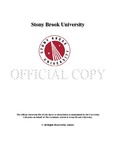| dc.identifier.uri | http://hdl.handle.net/1951/59937 | |
| dc.identifier.uri | http://hdl.handle.net/11401/71525 | |
| dc.description.sponsorship | This work is sponsored by the Stony Brook University Graduate School in compliance with the requirements for completion of degree. | en_US |
| dc.format | Monograph | |
| dc.format.medium | Electronic Resource | en_US |
| dc.language.iso | en_US | |
| dc.publisher | The Graduate School, Stony Brook University: Stony Brook, NY. | |
| dc.type | Thesis | |
| dcterms.abstract | ? The key to designing a suitable material for bone replacement is to mimic the mineral component and the microstructure of natural bone. The novel artificial bone scaffold should have good mechanical properties, high porosity, bioactivity, and controllable degradation kinetics. In this work, a three-dimensional scaffold based on a polymer phase consisting of only naturally- derived components (gelatin and cornstarch) and a mineral phase (hydroxyapatite (HA)) was produced using supercritical CO2 as the foaming agent. By setting the pressure of the supercritical CO2 at 2500 psi and the temperature at 35??C, 3-D porous scaffolds were successfully fabricated and no organic solvent was used in the entire process. The results show the amount of the cornstarch to have a direct effect on the porosity, in that, without cornstarch the scaffold could not be foamed (the total volume has not increased in this case). Pore size of the scaffolds was influenced by the HA concentration. We also investigated the effect of two different gelatin cross-linking agents (trisodium citrate and EDC/NHS) and different cross- linking methods (infusion and immersion) on degradation kinetics and supercritical CO2 foaming. The results show that EDC/NHS cross-linked samples (by the immersion method) lasted longest for about 7 days at 37??C in SBF. | |
| dcterms.available | 2013-05-22T17:35:55Z | |
| dcterms.available | 2015-04-24T14:47:49Z | |
| dcterms.contributor | Meng, Yizhi | en_US |
| dcterms.contributor | Gersappe, Dilip | en_US |
| dcterms.contributor | Hadjiargyrou, Michael. | en_US |
| dcterms.creator | ZHANG, CHI | |
| dcterms.dateAccepted | 2013-05-22T17:35:55Z | |
| dcterms.dateAccepted | 2015-04-24T14:47:49Z | |
| dcterms.dateSubmitted | 2013-05-22T17:35:55Z | |
| dcterms.dateSubmitted | 2015-04-24T14:47:49Z | |
| dcterms.description | Department of Materials Science and Engineering | en_US |
| dcterms.extent | 83 pg. | en_US |
| dcterms.format | Application/PDF | en_US |
| dcterms.format | Monograph | |
| dcterms.identifier | http://hdl.handle.net/1951/59937 | |
| dcterms.identifier | Zhang_grad.sunysb_0771M_10285 | en_US |
| dcterms.identifier | http://hdl.handle.net/11401/71525 | |
| dcterms.issued | 2011-08-01 | |
| dcterms.language | en_US | |
| dcterms.provenance | Made available in DSpace on 2013-05-22T17:35:55Z (GMT). No. of bitstreams: 1
Zhang_grad.sunysb_0771M_10285.pdf: 3922579 bytes, checksum: fac6fdd95fc6292bbcc2d27713ae9a49 (MD5)
Previous issue date: 1 | en |
| dcterms.provenance | Made available in DSpace on 2015-04-24T14:47:49Z (GMT). No. of bitstreams: 3
ZHANG_grad.sunysb_0771M_10630.pdf.jpg: 3187 bytes, checksum: 17066d4449db985bb006951a280eccb1 (MD5)
ZHANG_grad.sunysb_0771M_10630.pdf.txt: 85090 bytes, checksum: d8bfed1f00175d7d55e5098dd12011ae (MD5)
ZHANG_grad.sunysb_0771M_10630.pdf: 6916203 bytes, checksum: 66b3431e3e108e915482d24c1a39be3e (MD5)
Previous issue date: 1 | en |
| dcterms.publisher | The Graduate School, Stony Brook University: Stony Brook, NY. | |
| dcterms.subject | Bone, Cornstarch, Gelatin, Hydroxyapatite, Supercritical Fluids | |
| dcterms.subject | Materials Science | |
| dcterms.title | A feasibility study on using supercritical fluid technology to develop a biomimetic 3D porous scaffold for bone tissue engineering | |
| dcterms.type | Thesis | |

